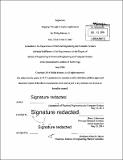| dc.contributor.advisor | Henry Lieberman. | en_US |
| dc.contributor.author | Mercer, Phillip, Jr | en_US |
| dc.contributor.other | Massachusetts Institute of Technology. Department of Electrical Engineering and Computer Science. | en_US |
| dc.date.accessioned | 2014-11-24T18:39:38Z | |
| dc.date.available | 2014-11-24T18:39:38Z | |
| dc.date.copyright | 2014 | en_US |
| dc.date.issued | 2014 | en_US |
| dc.identifier.uri | http://hdl.handle.net/1721.1/91848 | |
| dc.description | Thesis: M. Eng., Massachusetts Institute of Technology, Department of Electrical Engineering and Computer Science, 2014. | en_US |
| dc.description | Cataloged from PDF version of thesis. | en_US |
| dc.description | Includes bibliographical references (page 31). | en_US |
| dc.description.abstract | The steptorial is a new form of help system designed to assist new users in learning complex applications. Steptorials provide examples of high level user goals within applications using a hierarchical instruction set by breaking this goal into smaller goals, down to the level of individual interface interactions. Steptorials are unique in that they have they control structure of a reversible programming language stepper, allowing the user to step over, step back over, or step into any instruction. Further, the user may choose, at any time, to be shown how to do a step, be guided through it, or to use the application interface without constraint. This allows for varying the autonomy of the user at any step while reducing the risk of trying new operations. | en_US |
| dc.description.statementofresponsibility | by Phillip Mercer, Jr. | en_US |
| dc.format.extent | 36 pages | en_US |
| dc.language.iso | eng | en_US |
| dc.publisher | Massachusetts Institute of Technology | en_US |
| dc.rights | M.I.T. theses are protected by copyright. They may be viewed from this source for any purpose, but reproduction or distribution in any format is prohibited without written permission. See provided URL for inquiries about permission. | en_US |
| dc.rights.uri | http://dspace.mit.edu/handle/1721.1/7582 | en_US |
| dc.subject | Electrical Engineering and Computer Science. | en_US |
| dc.title | Steptorials : stepping through complex applications | en_US |
| dc.type | Thesis | en_US |
| dc.description.degree | M. Eng. | en_US |
| dc.contributor.department | Massachusetts Institute of Technology. Department of Electrical Engineering and Computer Science | |
| dc.identifier.oclc | 894250606 | en_US |
